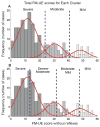Determining Levels of Upper Extremity Movement Impairment by Applying a Cluster Analysis to the Fugl-Meyer Assessment of the Upper Extremity in Chronic Stroke
- PMID: 27519928
- PMCID: PMC5299057
- DOI: 10.1016/j.apmr.2016.06.023
Determining Levels of Upper Extremity Movement Impairment by Applying a Cluster Analysis to the Fugl-Meyer Assessment of the Upper Extremity in Chronic Stroke
Abstract
Objective: To quantitatively determine levels of upper extremity movement impairment by using a cluster analysis of the Fugl-Meyer Assessment of the Upper Extremity (FMA-UE) with and without reflex items.
Design: Secondary analysis.
Setting: University and research centers.
Participants: Individuals (N=247) with chronic stroke (>6mo poststroke).
Interventions: Not applicable.
Main outcome measures: Cutoff scores defined by FMA-UE total scores of clusters identified by 2 hierarchical cluster analyses performed on the full sample of FMA-UE individual item scores (with and without reflexes). Patterns of motor function defined by aggregate item scores of clusters.
Results: FMA-UE scores ranged from 2 to 63 (mean, 26.9±15.7) with reflex items and from 0 to 57 (mean, 22.1±15.3) without reflex items. Three clusters were identified. The distributions of the FMA-UE scores revealed considerable overlap between the clusters; therefore, 4 distinct stroke impairment levels were derived.
Conclusions: For chronic stroke, the cluster analysis of the FMA-UE supports either a 3- or a 4-impairment level classification scheme.
Keywords: Cluster analysis; Rehabilitation; Stroke; Upper extremity.
Copyright © 2016 American Congress of Rehabilitation Medicine. All rights reserved.
Figures



References
-
- Woytowicz EJ, Rietschel J, Goodman RN, Whitall J, McCombe Waller S. Cluster analysis of upper extremity Fugl-Meyer Assessment defines levels of motor impairment severity. Combined Sections Meeting Neurology Section Poster Presentations; San Diego, CA. 2013.
-
- Ali M, English C, Bernhardt J, Sunnerhagen KS, Brady M. More outcomes than trials: a call for consistent data collection across stroke rehabilitation trials. Int J Stroke. 2013;8(1):18–24. - PubMed
-
- Fugl-Meyer AR, Jääskö L, Leyman I, Olsson S, Steglind S. The post-stroke hemiplegic patient. 1. a method for evaluation of physical performance. Scand J Rehabil Med. 1975;7(1):13–31. - PubMed
-
- van Wijck FMJ, Pandyan AD, Johnson GR, Barnes MP. Assessing Motor Deficits in Neurological Rehabilitation: Patterns of Instrument Usage. Neurorehabil Neural Repair. 2001;15(1):23–30. - PubMed
-
- Velstra I-M, Ballert CS, Cieza A. A systematic literature review of outcome measures for upper extremity function using the international classification of functioning, disability, and health as reference. PM R. 2011;3(9):846–860. - PubMed
Publication types
MeSH terms
Grants and funding
LinkOut - more resources
Full Text Sources
Other Literature Sources
Medical

